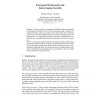Free Online Productivity Tools
i2Speak
i2Symbol
i2OCR
iTex2Img
iWeb2Print
iWeb2Shot
i2Type
iPdf2Split
iPdf2Merge
i2Bopomofo
i2Arabic
i2Style
i2Image
i2PDF
iLatex2Rtf
Sci2ools
WISA
2004
Springer
2004
Springer
Encrypted Watermarks and Linux Laptop Security
The most common way to implement full-disk encryption (as opposed to encrypted file systems) in the GNU/Linux operating system is using the encrypted loop device, known as CryptoLoop. We demonstrate clear weaknesses in the current CBC-based implementation of CryptoLoop, perhaps the most surprising being a very simple attack which allows specially watermarked files to be identified on an encrypted hard disk without knowledge of the secret encryption key. We take a look into the practical problems of securely booting, authenticating, and keying full-disk encryption. We propose simple improvements to the current CryptoLoop implementation based on the notions of tweakable encryption algorithms and enciphering modes. We also discuss sector-level authentication codes. The new methods have been implemented as a set of patches to the Linux Kernel series 2.6 and the relevant system tools.
| Added | 03 Jul 2010 |
| Updated | 03 Jul 2010 |
| Type | Conference |
| Year | 2004 |
| Where | WISA |
| Authors | Markku-Juhani Olavi Saarinen |
Comments (0)

